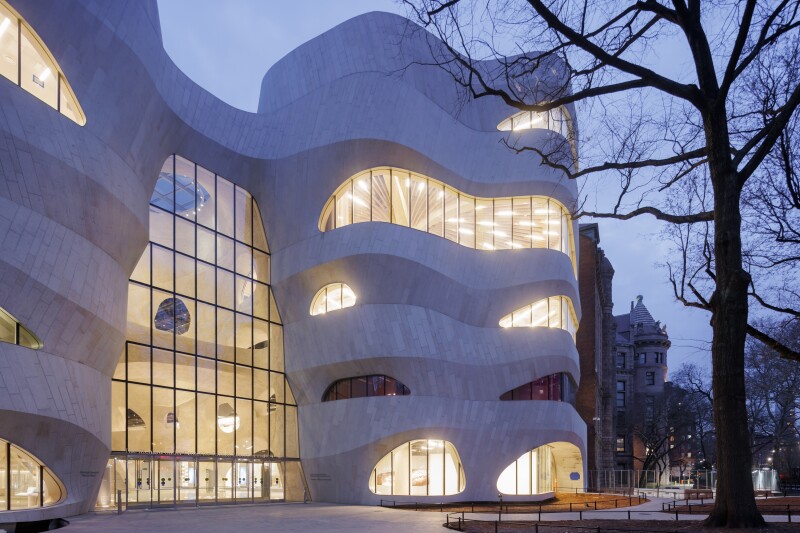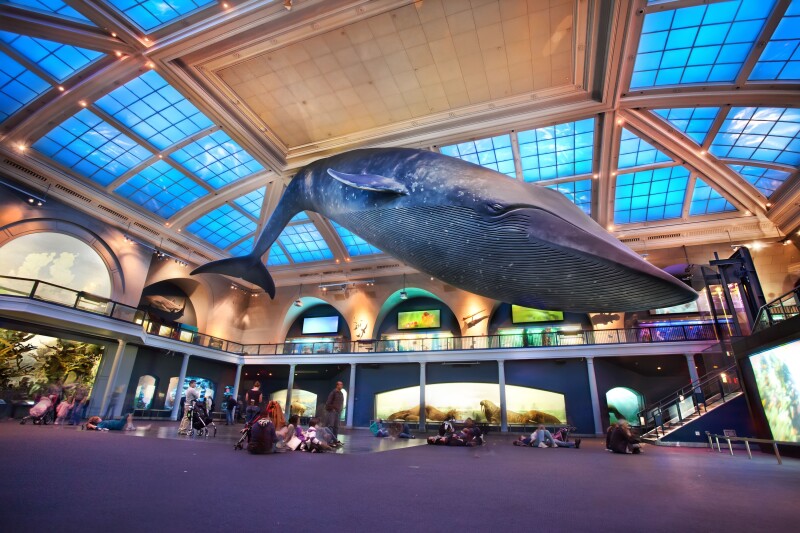Years in the making, the newest wing of New York City’s American Museum of Natural History opened to the public on Thursday, May 4. In addition to creating a new—and architecturally stunning—entrance to the museum on 79th Street and Columbus Avenue, the Richard Gilder Center for Science, Education, and Innovation houses several exciting new exhibits, including the museum’s first permanent display of insects in 50 years.
A functionally aesthetic building
Visitors enter the new wing through the canyon-like Kenneth C. Griffin Exploration Atrium, a five-story space designed by Studio Gang to look like it’s been eroded out of a solid block of concrete. (The architecture firm led by Jeanne Gang is also known for Chicago’s Vista Tower—the third tallest building in the city’s skyline and home to the upcoming St. Regis Chicago—as well as the new Arkansas Museum of Fine Arts in Little Rock.)
“During the design [process] we were searching for spaces that would encourage visitors to explore,” Gang said during a recent media preview. “And so this led us to look at geological landscapes where one can see how the natural forces actually shape the material.”
To achieve these organic shapes, Gang’s team used a material called shotcrete, which involves spraying concrete directly onto rebar and has primarily been used in infrastructure projects like tunnels and subways.
Here, form follows function. Additions to the museum over its 150-year history had created many dead ends, confusing circulation patterns, and exhibits with little to no natural light.
“We really thought about the building as a means to improve the visitor experience and circulation across the whole entire museum,” Gang said, pointing out that the bridges and curvature of the building were designed to encourage guests to flow into the surrounding spaces. Large windows and multiple skylights allow natural light into the museum, creating a “visceral connection to the outdoors,” according to Gang.

Located on the western side of the American Museum of Natural History, the Gilder Center’s entrance is on Columbus Avenue at 79th Street.
Photo by Iwan Baan
“This building makes new connections to existing buildings in over 30 different places,” Gang explained. “Visitors can now make loops between the halls and explore the museum’s delightful continuities and juxtapositions without getting those frustrating dead ends.”
But before guests head off to the Hall of Gems, look for the big blue whale, or follow the new pathways to the Rose Center for Earth and Space, there are many more reasons to stick around the Gilder Center beyond its atrium.
Live insects—including butterflies—on display
On the ground floor to the left of the entrance, the 5,000-square-foot Susan and Peter J. Solomon Family Insectarium brings visitors up close with live insects that normally get a bad rap so they can learn about the important role these creatures play in the planet’s ecosystems and food supplies. In addition to the colony of leafcutter ants (safely ensconced behind glass, of course), the Insectarium is home to an 8,000-pound resin model of a beehive, pinned specimens, and digital exhibits.

Leafcutter ants at the Gilder Center use a sealed-off skyway to carry leaves back to their nest to grow the fungus that sustains the colony.
Photo by Chris Ford/Flickr
One floor up is the 2,500-square-foot Davis Family Butterfly Vivarium, where visitors can walk among some 80 species of free-flying butterflies and learn about how these creatures are key environmental bellwethers. There’s also a pupae incubator that shows the butterfly life cycle in real time—if you’re lucky, you might see a swallowtail or blue morpho butterfly emerge from its chrysalis. While the Insectarium is included in the price of general admission to the museum, guests must purchase a timed ticket to the Vivarium for an extra fee.

Blue Morphos are just one of 80 species in the new Butterfly Vivarium at the Gilder Center.
Photo by Lyndsey Matthews
Immersive digital experiences and beyond
An immersive ticketed experience on the third floor called Invisible Worlds, is the “icing on the cake” of the Gilder Center, according to Ellen Futter, the former president of the American Museum of Natural History.
During this 12-minute looping 360-degree experience, “Visitors will enter the hidden realms of the natural world,” said Futter, who recently stepped down from her 30-year tenure now that the building is complete. “They will see, feel, and hear the very pulse of life in its various forms and ecosystems, including inside the human body and brain, enabling them to appreciate the essential fact that all life is connected.”

This scene in the Invisible Worlds immersive exhibit takes visitors inside California’s San Diego Bay, to experience the nightly commute of plankton, krill, and jellyfish to the sea surface.
Photo by Iwan Baan
In addition to the new permanent exhibition spaces, the Gilder Center is also home to the new David S. and Ruth L. Gottesman Research Library and Learning Center, whose reading room is accessible to the public, as well as the Learning Labs, which serve as next-generation educational zones for students using technology like a 22-foot-long panoramic projection system and 3D printers as learning tools.
How to visit
Open daily from 10 a.m. to 5:30 p.m., the Gilder Center is accessible from its main entrance on Columbus Avenue at 79th Street or through any other part of the American Museum of Natural History. Admission to the Gilder Center is included in the regular ticket price to the museum, which is $28 for adults and $16 for children; tickets can be purchased in advance at tickets.amnh.org. (Residents of New York, New Jersey, and Connecticut can enter on a pay-what-you-wish basis.) Timed tickets to the Invisible Worlds exhibit and the Davis Family Butterfly Vivarium must be purchased in addition to general admission.











